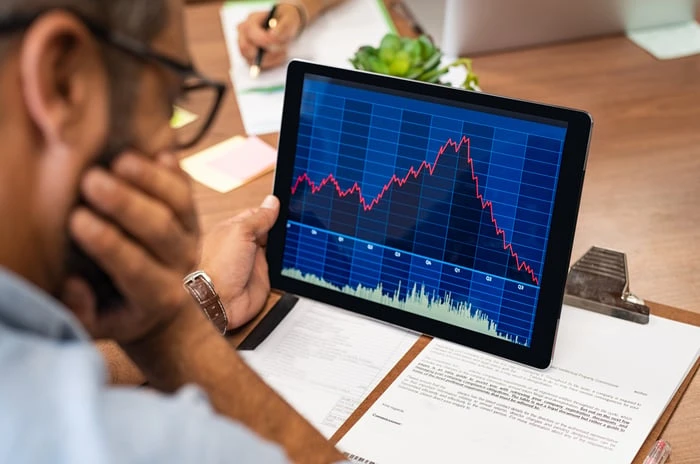Contents
The Allure of Artificial Intelligence on Wall Street
Over the past two years, few trends have captivated Wall Street investors as much as the rise of artificial intelligence (AI). The enthusiasm surrounding AI is driven by two primary factors.
Firstly, AI technology promises autonomous learning capabilities, allowing software and systems to evolve and improve over time without human input. This potential for self-enhancement and adaptability makes AI applicable across virtually every industry worldwide.
Secondly, the size of the AI market is staggering. According to PwC researchers, AI could contribute $15.7 trillion to the global economy by 2030, fueled by both consumption benefits and productivity enhancements.
With such promising prospects, AI has become a magnet for investors, particularly in companies like Nvidia. However, some analysts caution against assuming Nvidia’s current high valuation will persist.

Nvidia’s Meteoric Rise
At the end of 2022, Nvidia was a significant player in the tech sector with a market cap of $360 billion. Fast forward less than 18 months, and Nvidia briefly claimed the title of the world’s largest publicly traded company, reaching a peak market cap of $3.46 trillion.
This rapid ascent reflects the soaring demand for Nvidia’s H100 graphics processing unit (GPU) in high-compute data centers. According to TechInsights, Nvidia supplied approximately 98% of GPUs to data centers in 2022 and 2023, solidifying its position as the preferred hardware for training large language models (LLMs) and generative AI solutions.
Nvidia also benefits from its CUDA software platform, which helps retain client loyalty. This toolkit allows developers to optimize Nvidia GPUs for building LLMs.
Looking ahead, Nvidia’s future innovations are generating buzz. The forthcoming Blackwell chip promises enhanced energy efficiency, and CEO Jensen Huang has hinted at the 2026 release of the Rubin GPU architecture, featuring a new processor called Vera. This commitment to innovation strengthens Nvidia’s leadership in AI-GPU computing.
Nevertheless, Nvidia’s success has not silenced its critics.
Could Nvidia Face a Massive Decline?
Among Nvidia’s skeptics, financial writer and economist Harry Dent has been particularly vocal. In a June interview with Fox News Digital, Dent warned that the massive increase in money supply has placed the U.S. economy and stock market on precarious footing, dubbing the current scenario the “bubble of all bubbles.” He predicted Nvidia could see a 98% decline.
Dent argued, “This bubble has been going for 14 years. Instead of most bubbles [going] five to six, it’s been stretched higher, longer. So you’d have to expect a bigger crash than we got in 2008 to ’09.”
As an Nvidia bear, I don’t foresee a 98% drop. While some next-big-thing market leaders, like Canopy Growth and 3D Systems, have suffered near-98% losses, such a drastic fall for a market leader is rare.
Nvidia’s established revenue streams in gaming, cryptocurrency mining, and virtualization software could mitigate the impact of an AI bubble burst, preventing a 98% loss. However, a significant decline exceeding 75% remains plausible.

Lessons from History
While Dent’s prediction of a 98% drop may be extreme, he raises an important point about historical patterns. Wall Street history may not repeat exactly, but it often follows familiar trends.
Over the past three decades, every major innovation has experienced an initial bubble-burst phase. Though the specific timing varies, the result is usually a sharp decline for market leaders.
Investors often overestimate the immediate utility of groundbreaking technologies. Although AI has a promising future, most businesses lack a concrete strategy to capitalize on their AI investments in the short term. This discrepancy suggests an AI bubble may be forming.
Historically, leading companies in transformative sectors have lost 75% or more of their value from peak to trough.
Additional concerns include prolonged insider stock selling without corresponding purchases. While there can be legitimate reasons for selling, such as tax considerations, buying typically indicates confidence in a stock’s future value. No Nvidia insider has bought shares on the open market since CFO Colette Kress in December 2020.
Moreover, Nvidia’s dominant AI-GPU market share could face challenges. Internal competition from its largest customers, who are developing their own AI-GPUs, poses a potential threat to Nvidia’s future orders.
While a 98% decline is unlikely, a substantial drop remains a strong possibility.
Investment Opportunities: A Second Chance
The Motley Fool Stock Advisor has a track record of outperforming the market, with a total average return of 755% compared to the S&P 500’s 165% since 2002. The analyst team is adept at identifying opportunities to “double down” on promising stocks.
Consider the following examples of successful double-down investments:
– Nvidia: A $1,000 investment in 2009 would now be worth $308,807.
– Netflix: A $1,000 investment in 2004 would now be valued at $375,918.
– Apple: A $1,000 investment in 2008 would have grown to $42,091.
Currently, the team is issuing “Double Down” alerts for three remarkable companies. Don’t miss this unique opportunity.
See the stocks ›
*Stock Advisor returns as of 09/17/2024




